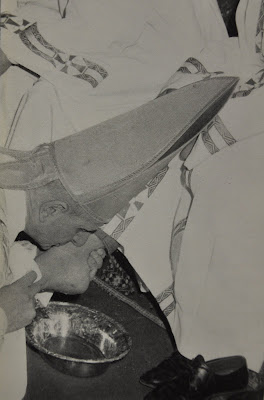

It was the SSPX which from its earlier years has always been squarely behind the promotion of the "1962" Roman Missal. Perhaps this was not so wise. On this blog I have never referred to the Classical Rite/Usus Antiquior/Gregorian Rite/Tridentine Rite/Extraordinary Form as the "1962 Missale Romanum." Why? Because this Bugnini-ized 1962 edition is problematic thanks to its Holy Week section.

Perhaps I'm missing something but why do you have photos of John XXIII's and Paul VI's participation in the Holy Thursday Service of the Washing of the Feet as "Bugnini Holy Week"? I do note that they both wear miters which they don't do now.
ReplyDeleteThere is no washing of the feet in the pre-Bugnini Holy Week.
ReplyDeleteActually there was. It was simply a separate ceremony, usually some time after the Maundy Thursday Mass and stripping on the altar. The priest (or bishop), vested in a purple cope, and his deacons, in folded chasubles, would enter a side chapel where 13 men would be seated. The deacon would say the munda cor meum and sing the Gospel of the Mass, then the priest would wash the feet of the 13 men (ideally priests or seminarians, but usually only at cathedrals) while a series of Gregorian antiphons would be sung. There would be a Collect-like prayer after the washing and the ceremony would be done. Bishop would perform this ceremony with the mitre on his head. Whenever the Pope performed this ceremony the men would be offered some small snacks (nuts, grapes, olives etc) afterward. It should also be noted that the reason for 13 men, as opposed to the intuitive 12, is that, tradition has it, St Gregory the Great was performing this ceremony in the Lateran Archbasilica when a 13th man appeared, a man with such a kind and perfect face that the saintly pontiff thought it must have been an angel, or Our Lord Himself.
ReplyDeleteIn the Bugnini Holy Week the washing is inserted into the time given for the sermon (which is a non-stop rubric in everything Bugnini did; Lord forbid we ever do a liturgical function outside of Mass). There are only 12 people, who are supposed to be congregants now—which is problematic because the use of clergy in the older rite was supposed to symbolize the Apostles, the first bishops. The vestments are those of the Mass and not penitential in nature. There is no Gospel, having been sung already at the Mass, and the number of antiphons is reduced. There might be a prayer after the ceremony, if I remember. Palm Sunday, Good Friday, and the Easter Vigil were quite unique, but fell hard under Bugnini's archaeological pike. Maundy Thursday, which was not that unique a day compared to the others of Holy Week, liturgically speaking, evidences that he just really wanted to change everything he could.
There is nothing wrong with the "mandatum" when done correctly.
ReplyDeleteGreat post, and I agree completely. 1962 needs to be chucked out the same window John XXIII wanted to let the "fresh air" in.
ReplyDeletePre-Bugnini Holy Week is off the radar for the SSPX.
ReplyDeleteI am also missing something as you say here that you disapprove of the Bugnini Holy Week (which I thoroughly agree with) but then want raised to the altars the man who actually caused it to be implemented, and actually gave Bugnini the job in the first place!
ReplyDeleteAnonymous Feb 21 1:35,
ReplyDeleteAt the Mandatum the deacon and subdeacon assisting the bishop (or priest) do not wear folded chasubles. Whilst the bishop (or priest) wears a violet stole and cope the assisting ministers wear white dalmatic and tunicle.
It was Pius XII who first started tinkering with the Holy Week liturgy (as promulgated in 1955). A harbinger of things to come?
ReplyDeleteThe 1962 Missal is also problematic because of it's abolition of teh folded tunicles and broad stoles.
ReplyDelete